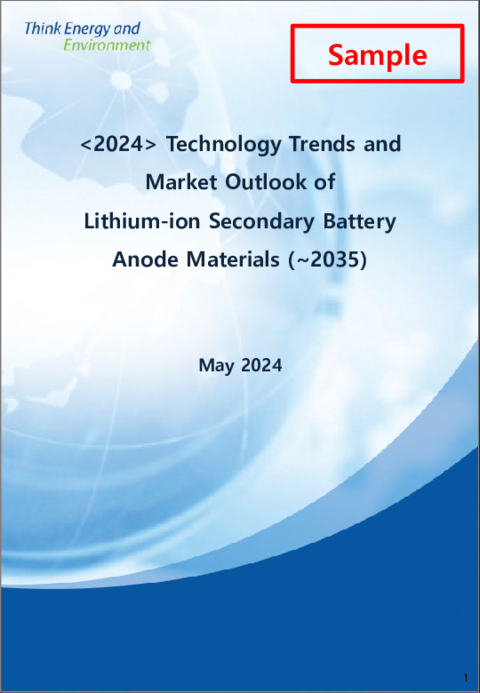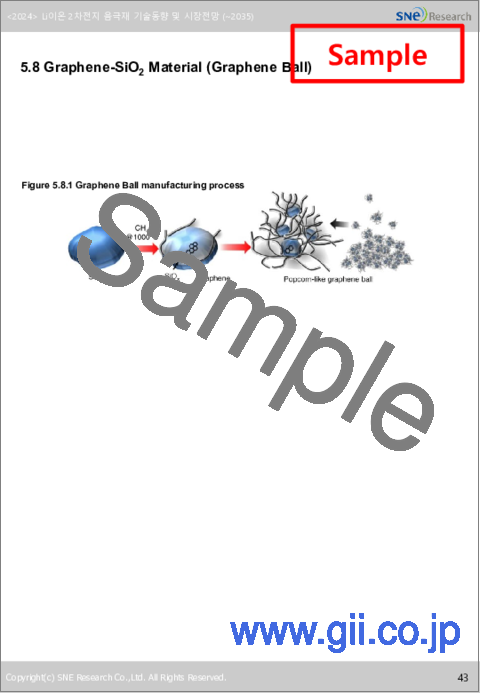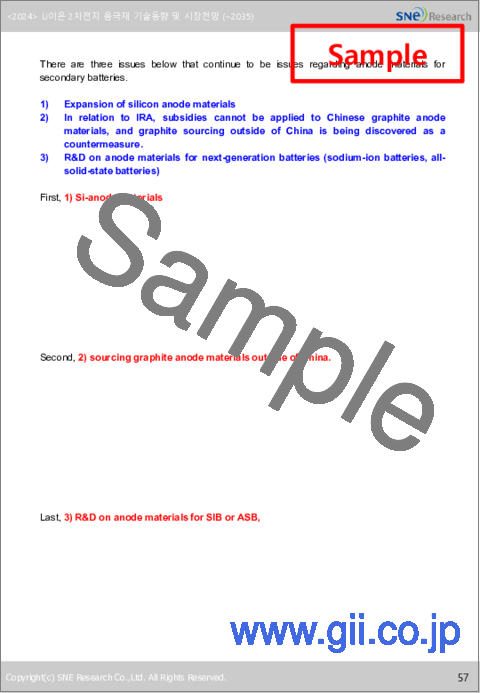|
|
市場調査レポート
商品コード
1487709
リチウムイオン二次電池負極材料の技術動向と市場見通し<2024> Technology Trends and Market Outlook of Lithium-ion Secondary Battery Anode Materials |
||||||
|
|||||||
| リチウムイオン二次電池負極材料の技術動向と市場見通し |
|
出版日: 2024年05月21日
発行: SNE Research
ページ情報: 英文 607 Pages
納期: お問合せ
|
全表示
- 概要
- 目次
二次電池の負極材料については、引き続き以下の3つが課題となっています。
(1)急速充電問題によるシリコン負極材料の拡大
(2)IRAとの関係で、中国産の黒鉛負極材料に補助金が適用できず、その対策として中国以外の黒鉛の調達先が発掘されつつあります。
(3)次世代電池用負極材料の研究開発(ナトリウムイオン電池、全固体電池)
まず、(1)シリコン負極材料は、高比容量によるエネルギー密度の向上と高速充電へのニーズから強力に推進されていますが、最大の問題は、有力なシリコン負極材料プラットフォームがまだ登場していないことです。
現在主流のシリコン負極材料であるSiOxやSi-Cはまだかなり高価であり、現在研究開発されている新技術、新製品、新製法と比べて技術的および価格的な優位性が確立されているとは言いがたいです。現在、世界では100社を超える電池メーカー、材料メーカー、中堅企業、ベンチャー企業、あるいは学術/研究機関がシリコン負極材料に関するさまざまな研究開発や製品化を進めており、今後、先進技術を利用した製品や製法が登場してくると見られます。
次に、(2)中国以外の黒鉛負極材料の調達先の発掘です。現在、LIB負極材料の98%は黒鉛であり、黒鉛供給の90%超を中国企業が占めています。米国が提案したIRA法案に基づき、当初は2025年1月から中国などのFEOC(Foreign Entity Of Concern)の企業が製造した負極材料を含むxEV用電池には補助金を支給しないことが決まっていましたが、現実には適用が困難でした。そこで2024年5月、この条件の発動を2年延期し、2027年1月から適用することを決定しました。
2年間時間ができたとはいえ、中国以外の黒鉛負極材料の調達先を早急に見つけなければなりません。そこで、米国や欧州の黒鉛企業を探す必要がありますが、技術や量の面で適切な供給先を見つけることは容易ではありません。
最後に、(3)SIBまたはASB負極材料の研究開発です。ハードカーボンは主にナトリウムイオン電池の負極材料として使用されており、採掘量が限られているリチウム(Li)の代わりにナトリウム(Na)を電池の輸送材料として採用しています。また、シリコン負極材料では、ナノシリコンの担体として多孔質のハードカーボンが使用されるケースもあり、ハードカーボンはグラファイトやシリコン以外の材料の中でも負極材料として使用できる重要な材料と考えられています。
全固体電池(ASSB)の負極材料として炭素系材料(グラファイト、ハードカーボン)やシリコンを使用するケースもありますが、Li金属も継続的に検討されており、Li金属が使用されれば、二次電池負極材料の幅が広がることが予測されます。アモルファス炭材料料であるハードカーボンや、完全金属であるリチウム負極材料の動向に注目すべきです。この動向に沿って研究開発または一部応用が進められている代表的な新負極材料候補としては、シリコン系とLi金属があり、既存の炭素系負極材料の改良も並行して進められているほか、無負極や急速充電技術の研究も活発に進められています。
当レポートでは、リチウムイオン二次電池負極材料について調査分析し、各地域のシリコン負極材料企業の状況や、シリコン系材料とLi金属を中心とした最新の技術動向、急速充電技術設計と無負極技術の業界動向などを提供しています。
目次
索引
レポートの概要
第1章 負極材料技術の状況と開発動向
- イントロダクション
- 負極材料の種類
- Li金属
- 炭素系負極材料
- 負極材料開発状況
第2章 炭素系負極材料
- 炭素系負極材料の概要
- 炭素系負極材料の製造
- 気相炭化
- 液相炭化
- 固相炭化
- ソフトカーボン系負極材料
- 構造特性
- 電気化学的性質
- 電極反応メカニズム
- 生産方式
- 人工黒鉛
- 天然黒鉛
- 低温焼成炭素
- その他の材料
- ハードカーボン系負極材料
- 構造特性
- 電気化学的性質
- 電極反応メカニズム
- 生産方式
- 廃電池からの炭素系負極材料の回収とリサイクル
第3章 合金系負極材料
- 合金系負極材料の概要
- 合金系負極材料の特性
- 合金系負極材料の問題点と解決策
- 代表的な問題
- 金属複合負極材料
- 金属炭素複合負極材料
- SiOx系負極材料
- 構造特性
- 電気化学的性質
- 生産方式
- プレリチウム化プロセスの応用
- Si系負極材料の実用化に関する調査
- 電気化学的挙動の違い
- 単一Si電極とSi/グラファイト混合電極
- その他のSi系負極材料
- 3D多孔質シリコン
- シリコンナノチューブ
- 金属/合金薄膜負極材料
第4章 複合負極材料
- 酸化物系負極材料
- 窒化物系負極材料
- 2次元層状無機化合物(Mxene)
第5章 高出力負極材料
- 高出力負極材料の概要
- 挿入材料
- カーボン材料
- LTO(Li4Ti5O12)
- 合金系材料
- 遷移材料
- ナノ構造微粒子
- ナノ構造マイクロカーボン材料
- ナノ構造マイクロLi4Ti5O
- ナノ構造マイクロSi-カーボン複合活性材料
- マルチチャネル構造グラファイト
- Si-グラファイトハイブリッド材料(SEAG)
- グラフェン-SiO2材料(グラフェンボール)
- 負極の観点から見た急速充電
- 負極材料の影響要因
- 電極の影響要因
- 主要電池メーカーの急速充電技術設計
- 急速充電用負極技術開発の事例
- 結論と見通し
第6章 Li金属負極
- Li金属負極の概要
- Li金属負極の研究開発状況
- Li金属負極の課題と実用化の見通し
- 無負極LIB
第7章 負極の安全性に対する影響
- 負極の熱安定性
- 急速充電時の安全性
第8章 世界の負極材料の供給状況と見通し
- 負極材料の需要の見通し:用途別(2021年~2035年)
- 負極材料の需要の見通し:タイプ別(2021年~2035年)
- 負極材料の総出荷数(供給):サプライヤー別(2021年~2024年)
- 負極材料の総出荷数(供給)M/S:サプライヤー別(2021年~2024年)
- SDI/LGC/SKI/Panasonic/CATL/ATL/BYD/Lishen/Guoxuan/AESC/CALB
- 天然黒鉛(NG)負極材料の出荷数:サプライヤー別(2021年~2024年)
- NG負極材料の出荷数:サプライヤー別(2021年~2024年)
- 人工黒鉛(AG)負極材料の出荷数:サプライヤー別(2021年~2024年)
- AG負極材料の出荷数:サプライヤー別(2021年~2024年)
- シリコン負極材料の出荷数とM/S:サプライヤー別(2023年)
- 負極材料サプライヤーの現状に関する包括的な分析(2023年)
- 負極材料サプライヤーNGの生産能力拡大計画と需給の見通し(2021年~2030年)
- 負極材料サプライヤーAG(SG)の生産能力拡大計画と需給の見通し(2021年~2030年)
- 負極材料の価格の見通し:タイプ別(2021年~2030年)
- 負極材料の市場規模の見通し(2021年~2030年)
第9章 負極材料需要の現状と見通し:LIBサプライヤー別
- 負極材料の全体的な需要の実績、見通し、課題
- 主要LIBサプライヤーの負極材料需要の現状と見通し
- 主要企業の需給状況
第10章 グラファイト系負極材料企業の現状
- 世界の上位12社
- BTR/Shanshan/Zichen/Kaijin/Shangtai/Shinzoom/XFH/Kuntian/Dongdao/POSCO/Resonac/Mitsubishi
- 中国/日本/韓国のその他の企業
- Hitachi/Mitsubishi/Nippon Carbon/JFE/Tokai Carbon/Showa Denko/Shinetsu/Kureha
- 米国/欧州/その他の地域の企業
- Syrah/Westwater/Talga/NMG/Next source Mat./Mangnis/Renascor/Epsilon/Urbix/Novonix/Anovion
第11章 シリコン系負極材料企業の現状
- 日本、韓国のSi負極企業
- Shin-Etsu/JMC (Japan Metal & Chemicals)/Daejoo Electronic Materials/Posco Future M/Posco Silicon Solution (Former TERA TECHNOS)/SKMG14 (SK Materials-Group14)/SK Ultimus (Nexeon)/MK Electronics/Iljin Electric/EG/Hansol Chemical/Innox Advanced Materials (TRS)/FIC New Materials/LPN/Osaka Titanium/TCK (Tokai Carbon Korea)/Truewin (formerly NM Tech)/Korea Metal Silicon/EN Plus/Lotte Energy Materials (Enwires)/Dongjin Semichem/SJ Advanced Materials/IL Science/S Material/HNS Co., Ltd./Wipinetech/Hana Materials/Grabsil/BSG Materials/Actro/Siri Energy
- 中国のSi負極企業
- IOPSILION, Tianmu/Chengdu Guibao/iAmetal, Beijing Yijin/Gotion/Shinghwa/Kingi/JereH/Huawei/Haoxin Tech/Guiyuan/Yuling New Energy/Zhejiang Lichen/Lanxi Zhide
- 米国、欧州、その他の地域のSi負極企業
- Group14 (US)/Nexeon (UK)/Sila Nano (US)/Amprius (US)/Enovix (US)/Elkem (Nor)/Enevate (US)/Neo Battery (Canada)/OneD (US)/Nanograf (US)/StoreDot (Israel)/Targray (Canada)/Global Graphene Group (US)/EO Cell (US)/ADVANO (US)/Nanospan (US)/LeydenJar (Nether.)/Trion Battery (Canada)/Cenate (Norway)/SiCONA (AU)/Alkegen (US)/pH Matter LLC (US)/Paraclete Energy (US)/Himadri Specialty Chem (India)/E-Magy (Nether)/Ionblox (US)/Nanomakers (Fra.)/SiLi-ion (US)/Ionic Mineral Tech (US)/Ionobell (US)/The Coretec group (US)/Enwires (Fra.)/FARADPOWER (US)/SilLion (US)/Talga (AU)/SGL Carbon SE (Ger)
第12章 参考文献
There are three issues below that continue to be issued regarding anode materials for secondary batteries.
1) Expansion of silicon anode materials due to fast charging issues
2) In relation to IRA, subsidies cannot be applied to Chinese graphite anode materials, and as a countermeasure to this, graphite sourcing sources outside of China are being discovered.
3) R&D on anode materials for next-generation batteries (Sodium-ion batteries, All-solid-state batteries)
First, 1) Silicon anode materials are being driven strongly due to the need for improved energy density and fast charging due to high specific capacity, but the biggest issue is that a dominant silicon anode material platform has not yet emerged.
SiOx and Si-C, which are currently the mainstream silicon anode materials, are still quite expensive, and it is difficult to say that technological and price superiority has yet been established compared to new technologies, products, and manufacturing methods currently being researched or developed. Currently, more than 100 battery companies, material companies, mid-sized companies, start-ups, or academic/research institutes around the world are conducting various research and development and product launches on silicon anode materials, so technologically advanced products and manufacturing methods will emerge in the future. In this report, we investigated these silicon anode material companies in detail.
Second, 2) discovering sourcing sources for graphite anode materials outside of China. Currently, 98% of LIB anode materials are graphite, and Chinese companies account for more than 90% of graphite supply. In accordance with the IRA bill proposed by US, it was initially decided not to provide subsidies for xEV batteries containing anode materials manufactured by companies in foreign countries of concern (FEOC) such as China from January 2025, but it was difficult to apply this in reality. Therefore, in May 2024, they decided to postpone the triggering of these conditions for two years and apply them from January 2027.
Although we have gained two years of time, we must immediately discover sources for graphite anode materials outside of China. Therefore, we need to look for graphite companies in the US or Europe, but it is not easy to find a suitable supplier in terms of technology and quantity. In this report, we also investigated the status of non-Chinese graphite anode material companies in detail, such as in Australia, Europe, and the United States.
Lastly, 3) R&D on SIB or ASB anode materials. Hard carbon is mainly used as the anode material for sodium-ion batteries, which adopted sodium (Na) as a transport material in batteries instead of lithium (Li), which has a limited amount of mining. In addition, in some silicon anode materials, porous hard carbon is used as a support for nano silicon, so hard carbon is considered an important material that can be used as the anode material among materials other than graphite and silicon.
In some cases, carbon-based materials (graphite, hard carbon) or silicon are used as anode materials for all-solid-state batteries (ASSB), but Li-metal is also being continuously reviewed, so if Li-metal is used, the scope of secondary battery anode materials is expected to be expanded. We should be interested in the trend of hard carbon, which is an amorphous carbon material, or lithium anode material, a complete metal. Representative new anode material candidates that are being researched/developed or partially applied in line with this trend include silicon-based and Li metal, and improvements to existing carbon-based anode materials are also being carried out in parallel, and research on anode-free and fast charging technology is actively underway. This report reflects these recent trends and R&D status.
In particular, the latest technological trends centered on silicon-based materials and Li metal were discussed in depth, and the performance improvement of existing and new materials and the R&D status of hybrid products were also examined. This report also looked at industry trends in fast charging technology design and anode-free technology.
In addition, this report analyzed the use of anode materials and SCM of major battery companies in detail for the past three years. Each type (natural graphite, artificial graphite, silicon-based) of supply-chain companies were divided into Tier1, Tier2, and countries, and more than 100 companies were analyzed in detail.
We hope this report will be helpful in analyzing the global secondary battery market, anode material market and in business strategy.
Table of Contents
INDEX
Report Overview
Chapter 1. Anode Material Technology Status and Development Trend
- 1.1. Introduction
- 1.2. Types of Anode Material
- 1.2.1. Li-metal
- 1.2.2. Carbon-based Anode Material
- 1.2.3. Anode Material Development Status
Chapter 2. Carbon-based Anode Material
- 2.1. Overview of Carbon-based Anode Material
- 2.2. Manufacturing Carbon-based Anode Material
- 2.2.1. Gas-phase Carbonization
- 2.2.2. Liquid-phase Carbonization
- 2.2.3. Solid-phase Carbonization
- 2.3. Soft Carbon-based Anode Material
- 2.3.1. Structural Properties
- 2.3.2. Electrochemial Properties
- 2.3.3. Electrode Reaction Mechanism
- 2.3.4. Manufacturing Method
- 2.3.5. Artificial Graphite
- 2.3.6. Natural Graphite
- 2.3.7. Carbon Calcinated in Low Temperature
- 2.3.8. Other Materials
- 2.4. Hard Carbon-based Anode Material
- 2.4.1. Structural Properties
- 2.4.2. Electrochemical Properties
- 2.4.3. Electrode Reaction Mechanism
- 2.4.4. Manufacturing Method
- 2.5. Recollecting and Recycling of Carbon-based Anode Materials from Waste Batteries
Chapter 3. Alloy-based Anode Material
- 3.1. Overview of Alloy-based Anode Material
- 3.2. Properties of Alloy-based Anode Material
- 3.3. Problems and Solutions of Alloy-based Anode Material
- 3.3.1. Representative Problems
- 3.3.2. Metal Composite Anode Material
- 3.3.3. Metal-Carbon Composite Anode Material
- 3.4. SiOx-based Anode Material
- 3.4.1. Structural Properties
- 3.4.2. Electrochemical Properties
- 3.4.3. Manufacturing Method
- 3.4.4. Application of Prelithiation Process
- 3.5. Research on Practical Application of Si-based Anode Material
- 3.5.1. Difference of Electrochemical Behaviors
- 3.5.2. Single Si Electrode and Si/Graphite Mixed Electrode
- 3.6. Other Si-based Anode Materials
- 3.6.1 3D Porous Si
- 3.6.2. Si Nanotube
- 3.6.3. Metal/Alloy Thin Film Anode Material
Chapter 4. Compound Anode Material
- 4.1. Oxide-based Anode Material
- 4.2. Nitride-based Anode Material
- 4.3 2D Planar Structure Inorganic Compound (Mxenes)
Chapter 5. High Power Anode Material
- 5.1. Overview of High Power Anode Material
- 5.2. Intercalation Material
- 5.2.1. Carbon Material
- 5.2.2. LTO(Li4Ti5O12)
- 5.3. Alloy-based Material
- 5.4. Transition Material
- 5.5. Nano-structured Micro Particles
- 5.5.1. Nano-structured Micro Carbon Material
- 5.5.2. Nano-structured Micro Li4Ti5O
- 5.5.3. Nano-structured Micro Si-Carbon Composite Active Material
- 5.6. Multi Channel Structure Graphite
- 5.7. Si-Graphite Hybrid Material (SEAG)
- 5.8. Graphene-SiO2 Material (Graphene Ball)
- 5.9. Fast Charging from Anode Perspective
- 5.9.1. Influence Factors of Anode Material
- 5.9.2. Influence Factors of Electrode
- 5.9.3. Fast Charging Technology Design of Major Battery Manufacturers
- 5.9.4. Cases of Anode Technology Development for Fast Charging
- 5.10. Conclusion and Outlook
Chapter 6. Li-metal Anode
- 6.1. Overview of Li-metal Anode
- 6.2. R&D Status of Li-metal Anode
- 6.2.1. Artificial Surface Protection Layer (ASEI, formation of Artificial SEI layer)
- 6.2.2. New Structure
- 6.2.3. Hybrid Structure
- 6.2.4. Electrolyte modification
- 6.3. Problem and Outlook of Practical Application for Lithium Metal Anode
- 6.4. Anode-Free LIB
Chapter 7. Anode's Effect on Safety
- 7.1. Thermal Stability of Anode
- 7.2. Safety During Fast Charging
Chapter 8. Global Supply Status and Outlook of Anode Material
- 8.1. Anode Material Demand Outlook by Application ('21~'35)
- 8.2. Anode Material Demand Outlook by Type ('21~'35)
- 8.3. Anode Material Total Shipment(Supply) Volume by Supplier ('21~'24)
- 8.4. Anode Material Total Shipment(Supply) M/S by Supplier ('21~'24)
- SDI/LGC/SKI/Panasonic/CATL/ATL/BYD/Lishen/Guoxuan/AESC/CALB
- 8.5. Shipment Volume of Natural Graphite(NG) Anode Material by Supplier ('21~24)
- 8.6. Shipment M/S of NG Anode Material by Supplier ('21~24)
- 8.7. Shipment Volume of Artificial Graphite(AG) Anode Material by Supplier ('21~24)
- 8.8. Shipment M/S of AG Anode Material by Supplier ('21~24)
- 8.9. Silicon Anode Material Shipment Volume & M/S by Supplier (In 2023)
- 8.10. Comprehensive Analysis of Anode Material Supplier Status (In 2023)
- 8.11. Anode Material Supplier NG Capa. Expansion Plan & Demand/Supply Outlook ('21~'30)
- 8.12. Anode Material Supplier AG(SG) Capa. Expansion Plan & Demand/Supply Outlook ('21~'30)
- 8.13. Anode Material Price Outlook by Type ('21~'30)
- 8.14. Anode Material Market Size Outlook ('21~'30)
Chapter 9. Current Status and Outlook of Anode Material Demand by LIB Suppliers
- 9.1. Anode Material's Overall Demand Performance, Outlook and Issues
- 9.2. Current Status and Outlook of Anode Material Demand by Major LIB Suppliers
- 9.3. Supply/Demand Status Among Major Companies
Chapter 10. Current Status of Graphite-Focused Anode Material Companies
- 10.1. Global Top12
- BTR/Shanshan/Zichen/Kaijin/Shangtai/Shinzoom/XFH/Kuntian/Dongdao/POSCO/Resonac/Mitsubishi
- 10.2. Other Companies in China/Japan/Korea
- Hitachi/Mitsubishi/Nippon Carbon/JFE/Tokai Carbon/Showa Denko/Shinetsu/Kureha
- 10.3. Companies in US/Europe/Other Regions
- Syrah/Westwater/Talga/NMG/Next source Mat./Mangnis/Renascor/Epsilon/Urbix/Novonix/Anovion
Chapter 11. Current Status of Silicon-Focused Anode Material Companies
- 11.1. Si-Anode Companies in Japan, Korea
- Shin-Etsu/JMC (Japan Metal & Chemicals)/Daejoo Electronic Materials/Posco Future M/Posco Silicon Solution (Former TERA TECHNOS)/SKMG14 (SK Materials-Group14)/SK Ultimus (Nexeon)/MK Electronics/Iljin Electric/EG/Hansol Chemical/Innox Advanced Materials (TRS)/FIC New Materials/LPN/Osaka Titanium/TCK(Tokai Carbon Korea)/Truewin (formerly NM Tech)/Korea Metal Silicon/EN Plus/Lotte Energy Materials (Enwires)/Dongjin Semichem/SJ Advanced Materials/IL Science/S Material/HNS Co., Ltd./Wipinetech/ Hana Materials/Grabsil/BSG Materials/Actro/Siri Energy
- 11.2. Si-Anode Companies in China
- IOPSILION, Tianmu/Chengdu Guibao/iAmetal, Beijing Yijin/Gotion/Shinghwa/Kingi/JereH/Huawei/Haoxin Tech /Guiyuan/Yuling New Energy/Zhejiang Lichen /Lanxi Zhide
- 11.3. Si-Anode Companies in US, Europe and Other regions
- Group14 (US)/Nexeon (UK)/Sila Nano (US)/Amprius (US)/Enovix (US)/Elkem (Nor)/Enevate (US)/Neo Battery (Canada)/OneD (US)/Nanograf (US)/StoreDot (Israel)/Targray (Canada)/Global Graphene Group (US)/EO Cell (US)/ADVANO (US) /Nanospan (US)/LeydenJar (Nether.)/Trion Battery (Canada)/Cenate (Norway)/SiCONA (AU)/Alkegen (US)/pH Matter LLC (US)/Paraclete Energy (US)/Himadri Specialty Chem (India)/E-Magy (Nether)/Ionblox (US)/Nanomakers (Fra.)/SiLi-ion (US)/Ionic Mineral Tech (US)/Ionobell (US)/The Coretec group (US)/Enwires (Fra.)/FARADPOWER (US)/SilLion (US)/Talga (AU)/SGL Carbon SE (Ger)






